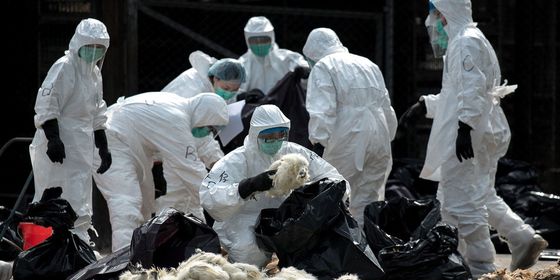The Chinese lab that creates viruses so we can beat them
We live our lives threatened by viruses and bacteria every day, often without even knowing it, while the invisible hands of international and national health agencies do what they can to protect us.
These organizations include the World Health Organization, government agencies, and various institutes that work to prevent pandemics—massive outbreaks of diseases that can create huge death tolls and even wipe out civilizations. Every time a new virus starts infecting people, scientists need to figure out how threatening that disease is to the population at large.
Right now, Chinese health authorities and the WHO have to deal with a strain of the avian influenza (bird flu): A(H7N9). One of the first lines of defense against a full-out bird flu epidemic in China right now is virologist Dr. Chen Hualan at the National Avian Influenza Reference Laboratory, located in the Harbin Veterinary Research Institute. However, Dr. Chen and her team is also involved in something that sounds straight out of a campy thriller film: creating viruses.
Don’t panic: There are good reasons why they do this, which we’ll get into. But first, let us get up to speed with some updates about viruses. You may have been told in school that viruses aren’t alive. This assertion, however, is debated by scientists, along with the question of where viruses even come from. To make the matter simpler, we will skip this discussion altogether and just settle with the premise that somehow, viruses exist, they are “agents” that replicate inside the cells of host organisms, and because they replicate, they are capable of mutating and evolving. This last part is why humans and animals face different strains of influenza every year—because new ones pop up all the time.
The scenario of humanity getting culled by a plain old flu is indeed possible. Just last week, SCMP reported that the current H7N9 outbreak has already produced an avian influenza virus mutation that is resistant to at least two antivirals, Tamiflu and Relenza, both recommended by the US Centers for Disease Control and Prevention as treatments for human flu caused by H7N9. With the virus’s death toll at 94 people between the start of 2017 and February 26, combined with the possibility that some people may be essentially untreatable, there is definitely reason for concern.
Luckily for us, at the moment, people can’t generally get the H7N9 flu virus from fleeting contact with infected people, only from infected birds and their fluids. There are strains of the bird flu that are human-transmissible, but those also happen to have mild symptoms, causing inconvenience but not usually death. What experts really fear happening is a mutation that would make the virus both highly transmissible and quite lethal.
This is where Dr. Chen and her team come in. They create influenza viruses that don’t exist in nature by hybridizing different flu viruses together, in order to study these different viruses before they actually appear and start to wreak havoc. This is called “gain-of-function research.” Its aim is to ensure that humanity is prepared with knowledge and even vaccines before lethal, highly transmissible viruses appear in nature.
Dr. Chen’s laboratory is rated at the international biosafety level of three, out of a possible four. Biosafety levels are determined based on the kind of work done in any given biological lab, with Level Three being given to labs that deal with agents that cause serious illness and which transmit to hosts through inhalation. Despite the precautions required to be taken by all who work in a lab like this, the idea of a lethal and transmissible virus escaping from a lab causes great fear among scientists and citizens alike.
Gain-of-function research has been criticized by the scientific community, as well as pundits, as being too risky and even unnecessary. In January 2012, prominent virologists who conduct gain-of-function research on the avian influenza strain H5N1 implemented a voluntary moratorium on their own research. The moratorium lasted nearly a year and was lifted in January 2013, despite concerns that this was not a long enough time for governments to consider how to ensure that no super-killer virus will escape from labs or fall into the hands of bioterrorists.
Dr. Chen herself has come under fire, when The Independent published criticism of her work in May, 2013, by various scientists, including Robert McCredie May (Lord May of Oxford). Lord May, a professor of zoology at the University of Oxford, evaluated Dr. Chen’s work as irresponsible, dangerous, and motivated by “blind ambition.” Dr. Chen’s response, in an interview with NewsChina magazine? “This is beyond the academic capacities of [Lord May], and I do not think he has a good understanding of the virus study….If the words had come from a virologist, I would probably be somewhat concerned.”
In the meantime, a study has come out from the Harvard Department of Global Health and Population arguing that we are not at all prepared for the next deadly epidemic, based on the recent epidemics that were handled by various health organizations worldwide.
Cover image from nanming.gov.cn












